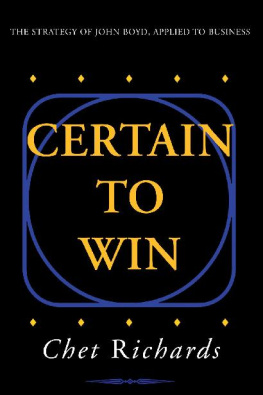CERTAIN TO WIN
The Strategy of John Boyd, Applied to Business
Chet Richards
Copyright 2004 by Chet Richards.
The author would like to express appreciation to Mary Boyd Holton, executrix of the John R. Boyd estate, for permission to quote from copyrighted material.
Library of Congress Number: | 2004092495 |
ISBN: | Hardcover | 1-4134-5377-5 |
Softcover | 1-4134-5376-7 |
All rights reserved. No part of this book may be reproduced or transmitted in any form or by any means, electronic or mechanical, including photocopying, recording, or by any information storage and retrieval system, without permission in writing from the copyright owner.
Xlibris Corporation
1-888-795-4274
www.Xlibris.com
24705
CONTENTS
To the late John Boyd, who encouraged me to start this project.
To my wife, Ginger Richards, who saw to it that I finished.
And to the late LTC Grover C. Richards, US Army,
survivor of Bataan, commander of US cavalrymen,
toughest guy I ever met, and a hell of a father.
If a general who heeds my strategy is employed, he is certain to win. Sun Tzu
I n 2002, the major airlines of the United States lost $8.6 billion, on
top of the $10.3 billion they had lost in 2001. Six of the seven largest airlines also engaged in such practices as charging business travelers ten times the fares they charged vacationers, imposing $100 change fees, and requiring immediate rebooking in case of a change (or the traveler lost the entire amount.)
One major airline made money in 2002 and one airline did not engage in any of these egregious practices. Both airlines are, of course, the same company: Southwest Airlines. If you give people reasons to avoid your products and services, while a competitor does not, people will quit buying yours, or at least buy less of them. Now the critical question of strategy is that if I can see this and you can see it, what was the problem with the people who ran the other six airlines?
Starting in the mid-1970s, an obscure retired Air Force colonel, John R. Boyd, wondered the same thing about armies. In Vietnam, for example, we stuck with the same policies and strategies for nearly 10 years, up to when the last US personnel had to be evacuated by helicopter from the roof of our embassy in Saigon. Similarly, Boyd noted, at the start of World War II, the French and British were using the same outmoded strategies that had caused horrendous bloodbaths during World War I. The Germans, on the other hand, had developed the Blitzkrieg, and they sliced through the allied lines in a couple of weeks.
After considerable research, Boyd concluded that a small set of principles formed the foundation for the German victory and that they were primarily cultural, that is, they dealt with the behavior of people in groups. These principles of the Blitzkrieg do not give instructions on how to deploy tanks on the battlefield. Rather they aim to attack the ability of the other side to make effective decisions under conditions of danger, fear, and uncertainty and to increase our ability to function well under these same conditions. There was, in other words, little exclusively military about Boyds philosophy of conflict.
Over Christmas vacation in 1987, after Boyd had completed the bulk of his work, I happened upon Tom Peters Thriving on Chaos . It struck me that Peters could have modeled his organizational climate and culture after Boyds. Moreover, Peters insisted that his recommendations enabled companies to reach decisions quickly, which was a point Boyd had been briefing around the Pentagon for the last 10 years. Although Peters did not mention Boyd by name, their conclusions were too similar to be simple coincidence.
I called Boyd and told him that he had to read Peters book. He did, and that led him to the Toyota Production System and the works of the creators of that system, particularly Shigeo Shingo and Taiichi Ohno, and to the papers just published by researchers from the International Motor Vehicle Program underway at MIT to see if the Japanese did build better cars cheaper, or whether they were dumping them at below cost into the US market.
The upshot of all this was that Boyd concluded that the Toyota Production System was another implementation of the principles he had associated with the Blitzkrieg. As odd as this may seema doctrine of war and a car manufacturing system turning out to be brothers under the skinthey both use time as their principle strategic device, their organizational climates share several elements, and they both trace back to the school of strategy whose earliest known documentation is Sun Tzus The Art of War .
Peters later wrote me that he had indeed read about Boyds work in James Fallows 1982 book, National Defense , but had overlooked it in the details of preparing references for his book. Boyd and Peters did meet on one occasion, and Peters featured Boyd in a column, calling the OODA loop the real nub of competitiveness. Boyd also appears several times in Peters latest book, Re-imagine! At about the time Peters was finishing Re-imagine! incidentally, US Marines on the other side of the world were debating how they would use Boyd and the OODA loop in the final assault on Baghdad.
My plan in this book is to introduce Boyds philosophy of conflict, for which Ill use the term maneuver conflict, by examining how it works in the two primary areas where it has been applied: in armed conflict as maneuver warfare and in manufacturing as the Toyota Production System, or as it is more widely known, lean production. This is a technique Boyd called many sided, implicit cross referencing, which means to slice the problem a number of ways, draw ideas from across a range of disciplines, and see if we can discern common patterns.
The principles of maneuver conflict not only explain why the managers of the largest US airlines are running their companies into the ground, they also prescribe solutions. Southwest Airlines, the one consistently profitable major, operates more according to the principles of maneuver conflict than does its competitors, although I have no idea whether Herb Kelleher and the other creators of their system ever heard the term or studied any of its concepts. It would not be too far-fetched, since the military, particularly the Marine Corps, has adopted elements of maneuver warfare since the mid-1980s, and there are many ex-service members working at the airlines.
This book began in 1988 from a briefing on maneuver warfare and business. Boyd read, commented on, and corrected every draft until his death in 1997. The chapters on climate and strategy are very similar to the last manuscript Boyd saw, although I have updated the examples and changed a few buts to however. I have also had the opportunity to re-read his exegesis of strategy, Patterns of Conflict , a few more times, discuss it with his other surviving colleagues, and present it to military and commercial audiences.
Many thanks also to the people without whose support this book would not have happened: Col Mike Wyly, USMC (ret.), Boyds co-conspirator in installing maneuver warfare as Marine Corps doctrine, who read several drafts and kept me out of trouble when I ventured into maneuver warfare; Col G. I. Wilson, USMCR, co-originator of the concept of fourth generation warfare, whose insights on applying Boyd to business made a difference early on; Chuck Spinney, Boyd acolyte and Pentagon insider, who told me that for Boyds ideas to grow, they had to reach people outside of the military; Robert Coram, author of Boyd, The Fighter Pilot Who Changed the Art of War , who insisted I resurrect the manuscript and read all the drafts after Boyd; Jeannine Addams, owner of Tarkenton & Addams, the only PR agency in the world run according to Boyd, who patiently made time in her busy days to read and discuss awkward passages and who took my photo for the cover; Dr. Linda Beckerman, colleague at Lockheed, who was present at the creation and has applied many of these ideas to the form of conflict known as project management; Mickey Pittman, founder and president of Lead the Way, Inc., who read the manuscript and contributed his insights from the viewpoint of the special operator; Lane Desborough of Honeywell, who gave the manuscript its final editing and sanity check; Kristin Wohlleben, of Tarkenton & Addams, who lent her design magic to the project; and my wife, Ginger Richards, who suffered not always patiently through the many drafts, and also selected the interior layouts and designed the cover.









